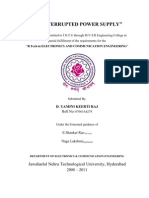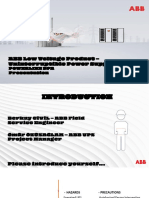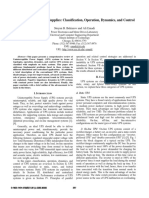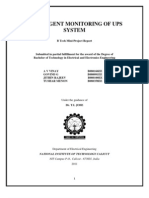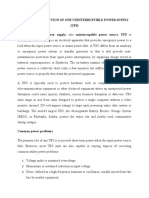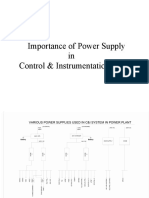Power Conditioning & Ups
Power Conditioning & Ups
Uploaded by
Xando FredericoCopyright:
Available Formats
Power Conditioning & Ups
Power Conditioning & Ups
Uploaded by
Xando FredericoOriginal Description:
Original Title
Copyright
Available Formats
Share this document
Did you find this document useful?
Is this content inappropriate?
Copyright:
Available Formats
Power Conditioning & Ups
Power Conditioning & Ups
Uploaded by
Xando FredericoCopyright:
Available Formats
POWER CONDITIONING & UPS
OVERVIEW OF DIFFERENT UPS TYPES
Most of the critical applications in data processing and other industries are now protected by Uninterruptible Power Supplies (UPS). It is
essential that the different types and performance levels are covered by international standards (IEC).
UPS systems are intended to improve the quality of AC power and provide a redundant (back-up) power source. Power quality defects which
may be improved by a UPS include surges, noise or sags.
Simplified Diagram of an On-Line Double Conversion UPS
AC
Input
Static
Switch
~=
Battery
Rectifier/
Charger
=~
Load
Inverter
In this type of UPS the load is isolated from the mains, hence all the power to the load flows through the inverter, offering continuous
protection and full isolation against surges, noise and sags. It offers true on line protection.
Simplified Diagram of an Offline UPS
AC
Input
Load
Filter
~=
Battery
Rectifier/
Charger
=~
Inverter
This type of UPS is not suitable for all applications because it does not use a static switch bypass and the switching times are longer. There
is no isolation between the load and the mains. There is also no output frequency control.
Simplified Diagram of an Line-Interactive UPS
AC
Input
Load
AVR
Transfer
Switch
Inverter
=~
Battery
This type of UPS does not provide isolation between the mains and the load. There is poor protection against spikes and poor efficiency.
There is no output frequency control but it has voltage regulation on the output.
You might also like
- Power Factor Measurement & Correction: Prepared By: Guided byDocument29 pagesPower Factor Measurement & Correction: Prepared By: Guided bySunil PillaiNo ratings yet
- High Power Ups Selection Methodology and Installation Guideline For High Reliability Power SupplyDocument7 pagesHigh Power Ups Selection Methodology and Installation Guideline For High Reliability Power SupplyCyriac SebastianNo ratings yet
- Uninterruptible Power Supply (UPS) Secure 650VADocument7 pagesUninterruptible Power Supply (UPS) Secure 650VAAaron EstacionNo ratings yet
- UPSDocument54 pagesUPSy m d100% (1)
- Comparacion Conversion DeltaDocument10 pagesComparacion Conversion Deltareigg9027No ratings yet
- 1000w Inverter PURE SINE WAVE Schematic DiagramDocument84 pages1000w Inverter PURE SINE WAVE Schematic DiagramandreboenNo ratings yet
- Ups Khushal PPT JSRDocument21 pagesUps Khushal PPT JSRKhushal BhalwalaNo ratings yet
- UPS Project NewDocument34 pagesUPS Project NewKrishna RajNo ratings yet
- Report On Power SupplyDocument14 pagesReport On Power SupplyBhavesh MaheshwariNo ratings yet
- Final of Atif UpsDocument99 pagesFinal of Atif UpsSajid HussainNo ratings yet
- UPS (Uninterruptible Power Supply)Document132 pagesUPS (Uninterruptible Power Supply)Erol Eren GözlüNo ratings yet
- Uninterruptible Power SupplyDocument6 pagesUninterruptible Power SupplyGinnethon CerveraNo ratings yet
- Uniterruptible Power Supply SystemDocument8 pagesUniterruptible Power Supply SystemSk The AlternatorNo ratings yet
- Offline UPS Reference Design Using The dsPIC DSCDocument86 pagesOffline UPS Reference Design Using The dsPIC DSCthietdaucongNo ratings yet
- Types of UPS 2Document3 pagesTypes of UPS 2Pedro MauricioNo ratings yet
- Voltage Power Supplies: Regulation of UninterruptedDocument5 pagesVoltage Power Supplies: Regulation of UninterruptedhuseyinkaksaNo ratings yet
- UPS Working Principle TypesDocument11 pagesUPS Working Principle Typeswasif upolNo ratings yet
- Experiment No. 1: DIFFERENT TYPES OF Uninterruptible Power Supply (UPS) Systems ObjectiveDocument2 pagesExperiment No. 1: DIFFERENT TYPES OF Uninterruptible Power Supply (UPS) Systems ObjectiveMichael Calizo PacisNo ratings yet
- 1000w Inverter PURE SINE WAVE Schematic DiagramDocument84 pages1000w Inverter PURE SINE WAVE Schematic DiagramPERWANA100% (3)
- UpsDocument27 pagesUpsmatthew02012010No ratings yet
- Uninterrupted Power Supply (UPS)Document4 pagesUninterrupted Power Supply (UPS)Asad MalikNo ratings yet
- Uninterruptible Power SupplyDocument18 pagesUninterruptible Power SupplyLuz ArriagaNo ratings yet
- Ups Technical SeminarDocument13 pagesUps Technical SeminarIyke Nokas OnokaNo ratings yet
- Uninterruptable Power SupplyDocument14 pagesUninterruptable Power Supplyjohnsmith7shadowsNo ratings yet
- Uninterruptible Power Supplies Classification Operation Dynamics PDFDocument8 pagesUninterruptible Power Supplies Classification Operation Dynamics PDFLê Khắc LâmNo ratings yet
- Advantages of Online UPS PDFDocument2 pagesAdvantages of Online UPS PDFRaju Malhotra100% (1)
- The Different Types of UPS SystemsDocument10 pagesThe Different Types of UPS SystemsDavid HicksNo ratings yet
- Working Principle of A Ups SystemDocument3 pagesWorking Principle of A Ups SystemIzi KaroNo ratings yet
- Ups UpsDocument92 pagesUps UpsHARSHIT SONI gs2117090No ratings yet
- Module 2 - Basics of PC HardwareDocument14 pagesModule 2 - Basics of PC HardwareSmitha RajeshNo ratings yet
- Ups Khushal PPT JSRDocument21 pagesUps Khushal PPT JSRKhushal BhalwalaNo ratings yet
- Uninterruptible Power Supply and InvertersDocument10 pagesUninterruptible Power Supply and InvertersnicenezaNo ratings yet
- Selection of Various Types of UPS (Part-2) : (2) Line-Inter Active UPSDocument14 pagesSelection of Various Types of UPS (Part-2) : (2) Line-Inter Active UPSJIMMY ANTONYNo ratings yet
- Intelligent Monitoring of Ups System: Under The Guidance ofDocument40 pagesIntelligent Monitoring of Ups System: Under The Guidance ofTushar MenonNo ratings yet
- Tsewg tp19Document24 pagesTsewg tp197xz77bmvqfNo ratings yet
- Backfeed Protection AppNoteDocument5 pagesBackfeed Protection AppNoteMarcelo OviedoNo ratings yet
- An On Line UPS System With Power FactorDocument9 pagesAn On Line UPS System With Power FactormaasifmustafaNo ratings yet
- Overview of Uninteruptive Power Systems (UPS) : Course ContentDocument34 pagesOverview of Uninteruptive Power Systems (UPS) : Course ContentSaber AbdelaalNo ratings yet
- UPS by Marwan AhmedDocument22 pagesUPS by Marwan Ahmednoor deenNo ratings yet
- Design Construction of One Uninterruptible Power Supply (UPS)Document25 pagesDesign Construction of One Uninterruptible Power Supply (UPS)Suva nilNo ratings yet
- UPS Presentation Ppt290721Document57 pagesUPS Presentation Ppt290721Aakanksha GahlautNo ratings yet
- Uninterruptible Power SupplyDocument5 pagesUninterruptible Power SupplyddipyenduNo ratings yet
- SMPS & UpsDocument22 pagesSMPS & UpsDudley Mosy ChifengaNo ratings yet
- Selecting The Topology For UpsDocument3 pagesSelecting The Topology For Upsimjohnty86No ratings yet
- Comparison of UPS Topologies: Line-Interactive Vs Online Vs OfflineDocument8 pagesComparison of UPS Topologies: Line-Interactive Vs Online Vs OfflineManish ShrivastavaNo ratings yet
- Overview On UPS SystemsDocument35 pagesOverview On UPS Systemsmikej 47600No ratings yet
- UPS Topologies & StandardsDocument11 pagesUPS Topologies & StandardsMuhammad BaihaqiNo ratings yet
- Reference Guide To Useful Electronic Circuits And Circuit Design Techniques - Part 2From EverandReference Guide To Useful Electronic Circuits And Circuit Design Techniques - Part 2No ratings yet
- Reference Guide To Useful Electronic Circuits And Circuit Design Techniques - Part 1From EverandReference Guide To Useful Electronic Circuits And Circuit Design Techniques - Part 1Rating: 2.5 out of 5 stars2.5/5 (3)
- Analog Dialogue Volume 46, Number 1: Analog Dialogue, #5From EverandAnalog Dialogue Volume 46, Number 1: Analog Dialogue, #5Rating: 5 out of 5 stars5/5 (1)
- A Case Study for a Single-Phase Inverter Photovoltaic System of a Three-Bedroom Apartment Located in Alexandria, Egypt: building industry, #0From EverandA Case Study for a Single-Phase Inverter Photovoltaic System of a Three-Bedroom Apartment Located in Alexandria, Egypt: building industry, #0No ratings yet
- Static-Inverter 1.0: A Complete Design Process to Convert D.C. to A.C. Electricity Using the Astable-MultivibratorFrom EverandStatic-Inverter 1.0: A Complete Design Process to Convert D.C. to A.C. Electricity Using the Astable-MultivibratorNo ratings yet
- Methods for Increasing the Quality and Reliability of Power System Using FACTS DevicesFrom EverandMethods for Increasing the Quality and Reliability of Power System Using FACTS DevicesNo ratings yet
- Practical Guides to Testing and Commissioning of Mechanical, Electrical and Plumbing (Mep) InstallationsFrom EverandPractical Guides to Testing and Commissioning of Mechanical, Electrical and Plumbing (Mep) InstallationsRating: 4 out of 5 stars4/5 (4)
- Introduction to Power System ProtectionFrom EverandIntroduction to Power System ProtectionRating: 4 out of 5 stars4/5 (2)
- Abc of Power Modules: Functionality, Structure and Handling of a Power ModuleFrom EverandAbc of Power Modules: Functionality, Structure and Handling of a Power ModuleNo ratings yet
- HVAC System Analysis & Selection (ch1)Document6 pagesHVAC System Analysis & Selection (ch1)Xando FredericoNo ratings yet
- Electrical Load EstimationDocument32 pagesElectrical Load EstimationXando Frederico100% (3)
- Public Procurement Bill b.8 - 2015Document49 pagesPublic Procurement Bill b.8 - 2015Xando FredericoNo ratings yet
- #5274-Gov N235-239 (Government Gazette For Engineer's Hourly Rate)Document13 pages#5274-Gov N235-239 (Government Gazette For Engineer's Hourly Rate)Xando FredericoNo ratings yet
- ACEN New ModelformDocument55 pagesACEN New ModelformXando FredericoNo ratings yet
- 03-Energy Efficiency in Buildings PDFDocument31 pages03-Energy Efficiency in Buildings PDFXando FredericoNo ratings yet
- Powertech TransformersDocument12 pagesPowertech TransformersXando FredericoNo ratings yet







